No, he’s not secretly Edward Scissorhands, but if he were, that might make his job a lot easier. The New York Comics and Picture-Story Symposium hosted a talk by award-winning illustrator and photo-collage artist Stephen Kroninger on the 22nd of October at Parsons The New School, moderated by Columbia University’s Ancient and Medieval, as well as graphic novels librarian, Karen Green.
Kroninger, who has been working in New York since 1978 is the author/illustrator of several children’s books, but is perhaps best known these days for his photo-collage illustrations that have appeared in Time Magazine, The New Yorker, The New York Times, and Newsweek, as well as featuring in a one-man show at MOMA in 2007. His earliest work as a cartoonist and illustrator for the Village Voice, among other newspapers, belies his comics roots, roots which continue to influence his oeuvre. Kroninger’s collage art, which he describes as “drawing with scissors” is innovative and distinctive, and he has recently completed a large work featuring Grand Central Station. His presentation on the 22nd took his audience behind the scenes of his production process and the highly personal brand of “storytelling” that he pursues.
Kroninger’s process for his large photo-collages is intricate, and starts with cartoon-like sketching over long periods of time in a given location. One of his long-term projects that was picked up by The New Yorker focused on Washington Square Park. As he returned to the park time and time again to sketch the characters he found there, he began to notice regulars who became part of his storytelling. As seasons passed and his sketches piled up, Kroninger decided that a multi-temporal approach was the only way to bring out the park and those who haunted it so if you look carefully at his figures, you’ll notice mixed seasonal elements in their clothing and activities. The square setting itself receded in favor of capturing the human element set off in white space. One particular dude really captured his attention, a guy wearing a STRYPER Christian heavy metal band t-shirt and blasting the tunes from a small speaker despite square prohibitions on sound-systems. Kroninger quipped that the rocker must be taking that rule up with God. Kroninger sketches people “on the go” and labors to find appropriate magazine images to cut, trim, and insert later to harmonize with the detail that he records in his notes. In a form without lines or use of tools aside from scissors, cuttings, and glue, Kroninger brings his sketches into full-color life with a passion for the personalities of his subjects.
He’s most influenced in his concepts by Matisse, who in his later years worked exclusively in a “drawing with scissors” technique. When teaching children how to find their own way into art, Kroninger reminds them “You can’t do it wrong” and frequently has to remind himself of that truism under the whip of his own exacting process. His large work “Grand Central Station” turned out to be a “nightmare” in terms of storytelling and his plans for the work changed a lot along the way toward completion. Initially, he hoped to compose the setting of the main hall of Grand Central Station, complete with clock, desk, and its grand ceiling, but as he focused on the figures, they too took over, leaving only the hint of a clock as a centering element. The figures, taking on a life of their own, demanded “room to breathe”, he explained.
Like his Washington Square piece, “Grand Central” soon became multi-seasonal, too, particularly evident in his observation of tourists from their Bermuda shorts and cameras to heavier jackets and anoraks. The result: a timeless illustration of life at one of New York’s busiest hubs, and what may seem the most ephemeral thing of all, the human tapestry that recreates the location daily.
Despite the hefty challenges of capturing people on the move, one of the most difficult obstacles Kroninger faces when working on a long-term project are, in fact, cats. His cat rolls around and sleeps on the carefully laid out cuttings and it’s back to the drawing board. You heard it here first: cats are the enemy of art. This doesn’t stop Kroninger from pondering “just how small” he can cut his collage images to achieve detail, from the sharp striping of clothes that seem a particular signature of his to creating the intricate logos of Duane Reade bags. Cats or no cats, Kroninger is big on minute detail. Another danger of being Kroninger: people on the street constantly think he’s “checking them out”. Well, he is. He wants to take a gander at their shoes or the particular set up of their baby-stroller, observational detail that does not always make him popular and there’s no time to explain; he’s too busy sketching.
When he’s not gathering visual material on the fly, he’s sorting through vast folders of magazine images for just the right hue or tone, for instance files labeled “Flesh 1” and “Flesh 2” (you can imagine what kinds of magazines best contribute to his stash). He’s come a long way from rural Lancaster County, Pennsylvania, where he devoured the Sunday funnies and Batman to become an illustrator, but some things stay the same. Music is still his biggest muse for artistic production and his warm-up exercises, many of which he posts on DRAWGER, feature curling and unwinding song lyrics as they inspire improv sketches. Aside from his major “location” projects, Kroninger is also still enthused by political subjects. Look out for his upcoming collage-portraits of both John Stewart and Stephen Colbert in The Baffler. The audience got a sneak-peak of his political portraits before teasing out Kroninger’s views on the role of humor in illustration and the embattled future of the publishing industry during Q and A.
Hannah Means-Shannon writes and blogs about comics for TRIP CITY and Sequart.org and is currently working on books about Neil Gaiman and Alan Moore for Sequart. She is @hannahmenzies on Twitter and hannahmenziesblog on WordPress.



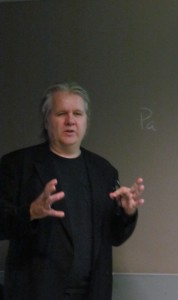
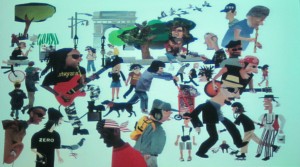
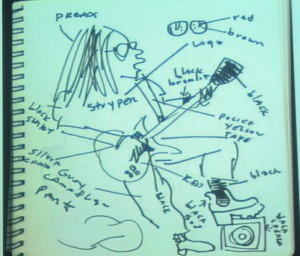
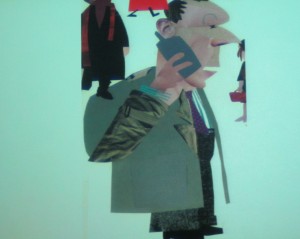
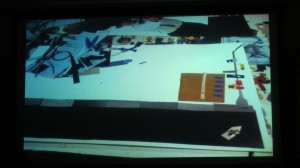
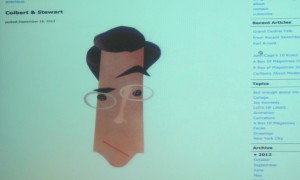






RT @Comixace: On the Scene: Stephen Kroninger, the Man with the Serious Scissors: No, he’s not secretly Edward Scisso… http://t.co/EqP …
Kroninger is great! Thanks, Hannah!
I really like how much he has up online for fans and followers to see what he works on, what he’s up to. Way to be digital!
Hannah Menzies liked this on Facebook.
Comments are closed.